technical data MERCEDES-BENZ CLK320 CABRIOLET 2002 A208 Owner's Manual
[x] Cancel search | Manufacturer: MERCEDES-BENZ, Model Year: 2002, Model line: CLK320 CABRIOLET, Model: MERCEDES-BENZ CLK320 CABRIOLET 2002 A208Pages: 346
Page 320 of 346
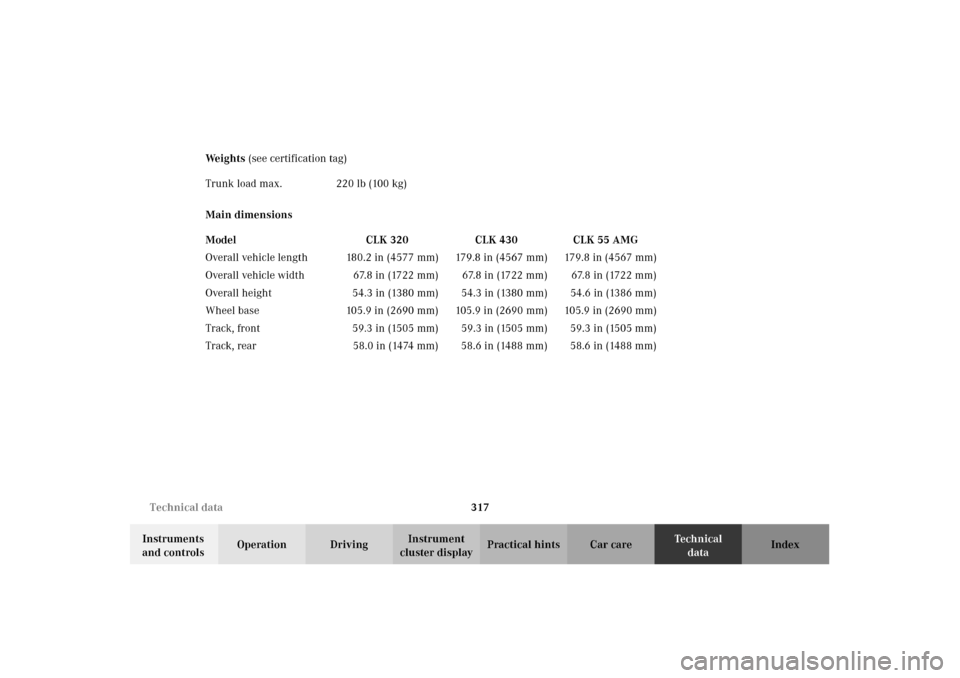
317 Technical data
Technical
data Instruments
and controlsOperation DrivingInstrument
cluster displayPractical hints Car care Index We i g h t s (see certification tag)
Main dimensions Trunk load max. 220 lb (100 kg)
Model CLK 320 CLK 430 CLK 55 AMG
Overall vehicle length 180.2 in (4577 mm) 179.8 in (4567 mm) 179.8 in (4567 mm)
Overall vehicle width 67.8 in (1722 mm) 67.8 in (1722 mm) 67.8 in (1722 mm)
Overall height 54.3 in (1380 mm) 54.3 in (1380 mm) 54.6 in (1386 mm)
Wheel base 105.9 in (2690 mm) 105.9 in (2690 mm) 105.9 in (2690 mm)
Track, front 59.3 in (1505 mm) 59.3 in (1505 mm) 59.3 in (1505 mm)
Track, rear 58.0 in (1474 mm) 58.6 in (1488 mm) 58.6 in (1488 mm)
J_A208.book Seite 317 Donnerstag, 31. Mai 2001 9:35 09
Page 321 of 346
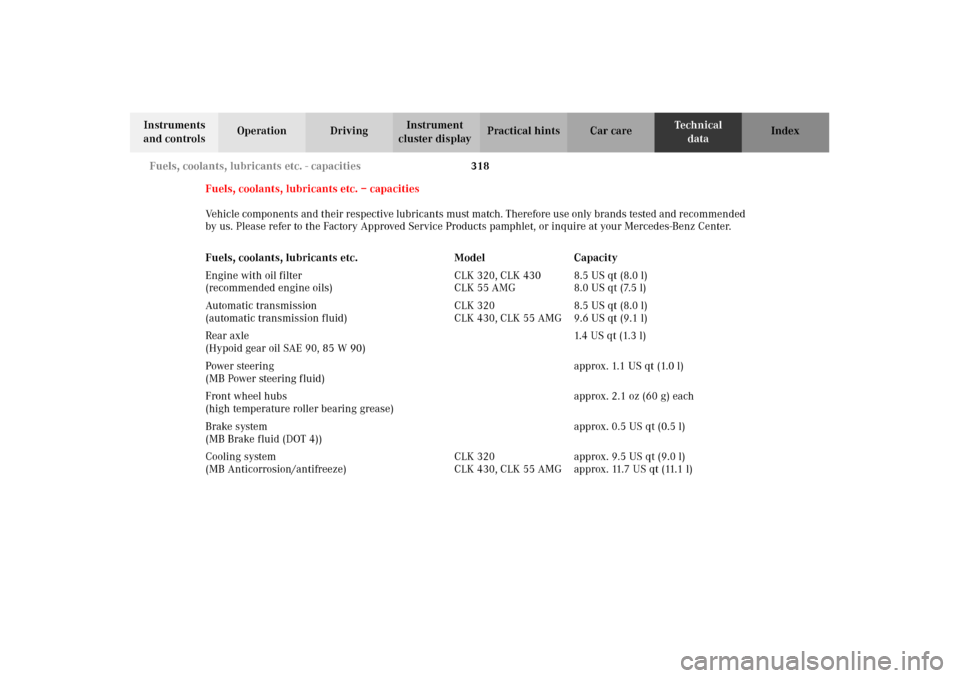
318 Fuels, coolants, lubricants etc. - capacities
Technical
data Instruments
and controlsOperation DrivingInstrument
cluster displayPractical hints Car care Index
Fuels, coolants, lubricants etc. – capacities
Vehicle components and their respective lubricants must match. Therefore use only brands tested and recommended
by us. Please refer to the Factory Approved Service Products pamphlet, or inquire at your Mercedes-Benz Center.
Fuels, coolants, lubricants etc. Model Capacity
Engine with oil filter
(recommended engine oils)CLK 320, CLK 430
CLK 55 AMG8.5 US qt (8.0 l)
8.0 US qt (7.5 l)
Automatic transmission
(automatic transmission fluid)CLK 320
CLK 430, CLK 55 AMG8.5 US qt (8.0 l)
9.6 US qt (9.1 l)
Rear axle
(Hypoid gear oil SAE 90, 85 W 90)1.4 US qt (1.3 l)
Power steering
(MB Power steering fluid)approx. 1.1 US qt (1.0 l)
Front wheel hubs
(high temperature roller bearing grease)approx. 2.1 oz (60 g) each
Brake system
(MB Brake fluid (DOT 4))approx. 0.5 US qt (0.5 l)
Cooling system
(MB Anticorrosion/antifreeze)CLK 320
CLK 430, CLK 55 AMGapprox. 9.5 US qt (9.0 l)
approx. 11.7 US qt (11.1 l)
J_A208.book Seite 318 Donnerstag, 31. Mai 2001 9:35 09
Page 322 of 346
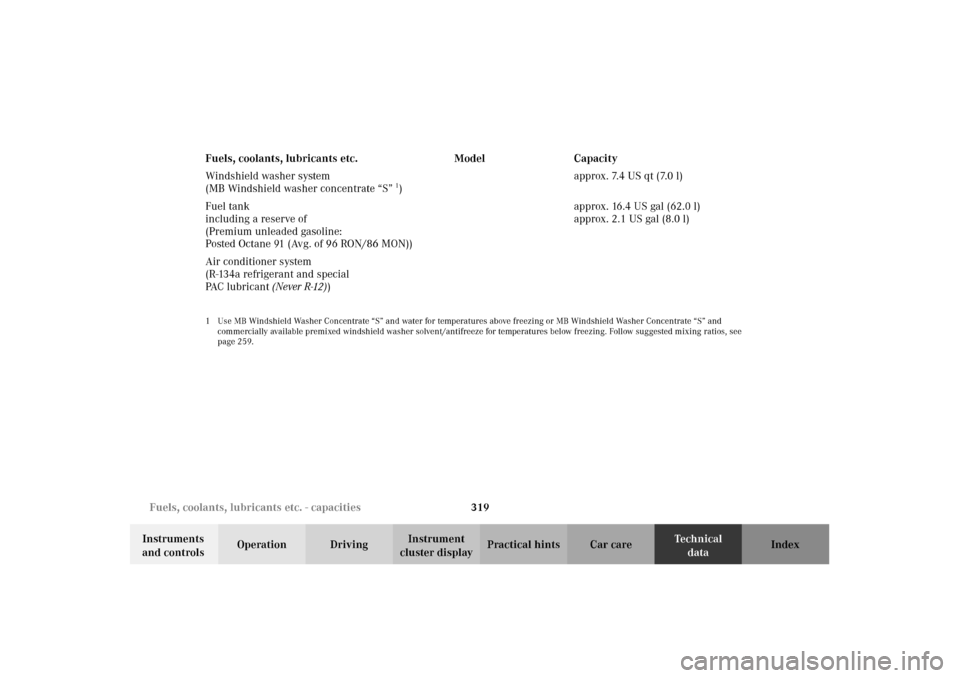
319 Fuels, coolants, lubricants etc. - capacities
Technical
data Instruments
and controlsOperation DrivingInstrument
cluster displayPractical hints Car care Index Windshield washer system
(MB Windshield washer concentrate “S”
1)approx. 7.4 US qt (7.0 l)
Fuel tank
including a reserve of
(Premium unleaded gasoline:
Posted Octane 91 (Avg. of 96 RON/86 MON))approx. 16.4 US gal (62.0 l)
approx. 2.1 US gal (8.0 l)
Air conditioner system
(R-134a refrigerant and special
PA C l u b r i c a n t (Never R-12))
1 Use MB Windshield Washer Concentrate “S” and water for temperatures above freezing or MB Windshield Washer Concentrate “S” and
commercially available premixed windshield washer solvent/antifreeze for temperatures below freezing. Follow suggested mixing ratios, see
page 259.Fuels, coolants, lubricants etc. Model Capacity
J_A208.book Seite 319 Donnerstag, 31. Mai 2001 9:35 09
Page 323 of 346
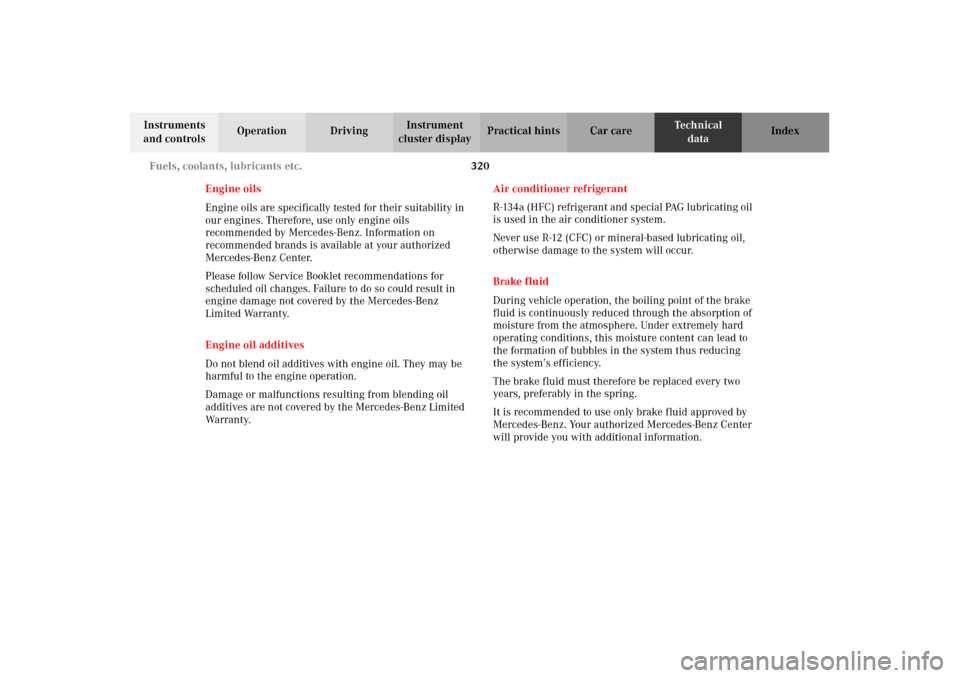
320 Fuels, coolants, lubricants etc.
Technical
data Instruments
and controlsOperation DrivingInstrument
cluster displayPractical hints Car care Index
Engine oils
Engine oils are specifically tested for their suitability in
our engines. Therefore, use only engine oils
recommended by Mercedes-Benz. Information on
recommended brands is available at your authorized
Mercedes-Benz Center.
Please follow Service Booklet recommendations for
scheduled oil changes. Failure to do so could result in
engine damage not covered by the Mercedes-Benz
Limited Warranty.
Engine oil additives
Do not blend oil additives with engine oil. They may be
harmful to the engine operation.
Damage or malfunctions resulting from blending oil
additives are not covered by the Mercedes-Benz Limited
Warranty.Air conditioner refrigerant
R-134a (HFC) refrigerant and special PAG lubricating oil
is used in the air conditioner system.
Never use R-12 (CFC) or mineral-based lubricating oil,
otherwise damage to the system will occur.
Brake fluid
During vehicle operation, the boiling point of the brake
fluid is continuously reduced through the absorption of
moisture from the atmosphere. Under extremely hard
operating conditions, this moisture content can lead to
the formation of bubbles in the system thus reducing
the system’s efficiency.
The brake fluid must therefore be replaced every two
years, preferably in the spring.
It is recommended to use only brake fluid approved by
Mercedes-Benz. Your authorized Mercedes-Benz Center
will provide you with additional information.
J_A208.book Seite 320 Donnerstag, 31. Mai 2001 9:35 09
Page 324 of 346
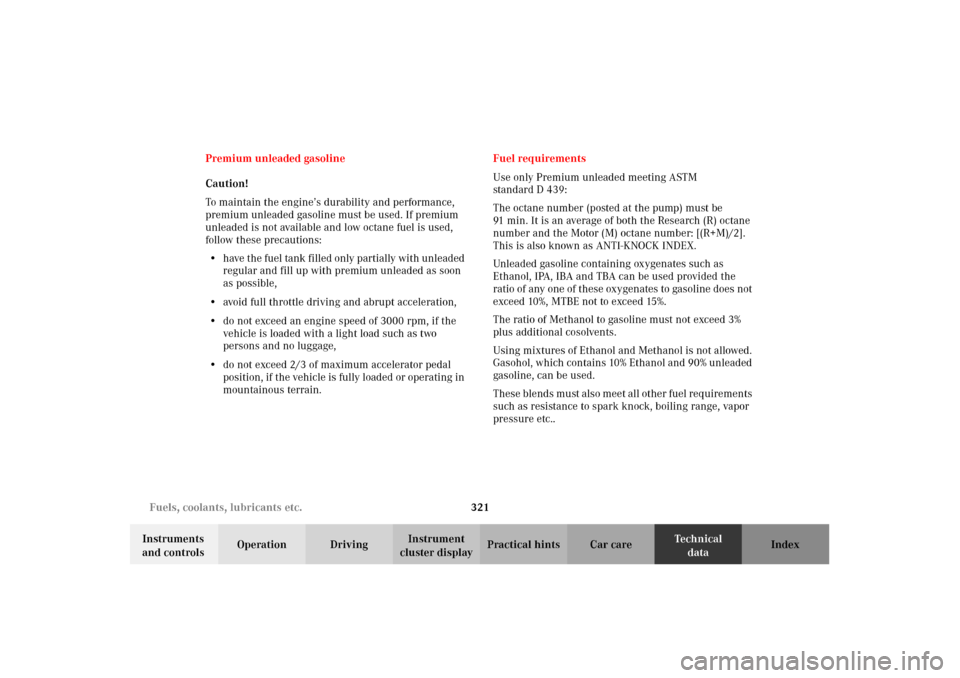
321 Fuels, coolants, lubricants etc.
Technical
data Instruments
and controlsOperation DrivingInstrument
cluster displayPractical hints Car care Index Premium unleaded gasoline
Caution!
To maintain the engine’s durability and performance,
premium unleaded gasoline must be used. If premium
unleaded is not available and low octane fuel is used,
follow these precautions:
•have the fuel tank filled only partially with unleaded
regular and fill up with premium unleaded as soon
as possible,
•avoid full throttle driving and abrupt acceleration,
•do not exceed an engine speed of 3000 rpm, if the
vehicle is loaded with a light load such as two
persons and no luggage,
•do not exceed 2/3 of maximum accelerator pedal
position, if the vehicle is fully loaded or operating in
mountainous terrain.Fuel requirements
Use only Premium unleaded meeting ASTM
standard D 439:
The octane number (posted at the pump) must be
91 min. It is an average of both the Research (R) octane
number and the Motor (M) octane number: [(R+M)/2].
This is also known as ANTI-KNOCK INDEX.
Unleaded gasoline containing oxygenates such as
Ethanol, IPA, IBA and TBA can be used provided the
ratio of any one of these oxygenates to gasoline does not
exceed 10%, MTBE not to exceed 15%.
The ratio of Methanol to gasoline must not exceed 3%
plus additional cosolvents.
Using mixtures of Ethanol and Methanol is not allowed.
Gasohol, which contains 10% Ethanol and 90% unleaded
gasoline, can be used.
These blends must also meet all other fuel requirements
such as resistance to spark knock, boiling range, vapor
pressure etc..
J_A208.book Seite 321 Donnerstag, 31. Mai 2001 9:35 09
Page 325 of 346
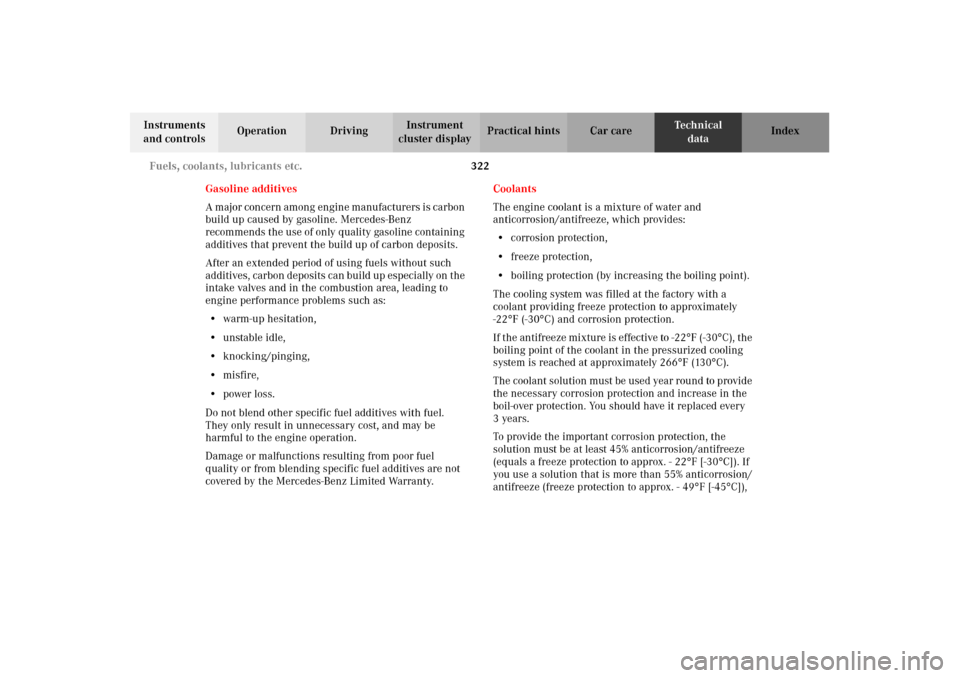
322 Fuels, coolants, lubricants etc.
Technical
data Instruments
and controlsOperation DrivingInstrument
cluster displayPractical hints Car care Index
Gasoline additives
A major concern among engine manufacturers is carbon
build up caused by gasoline. Mercedes-Benz
recommends the use of only quality gasoline containing
additives that prevent the build up of carbon deposits.
After an extended period of using fuels without such
ad ditives , car bon d ep osits c an bui ld up esp eci ally on t he
intake valves and in the combustion area, leading to
engine performance problems such as:
•warm-up hesitation,
•unstable idle,
•knocking/pinging,
•misfire,
•power loss.
Do not blend other specific fuel additives with fuel.
They only result in unnecessary cost, and may be
harmful to the engine operation.
Damage or malfunctions resulting from poor fuel
quality or from blending specific fuel additives are not
covered by the Mercedes-Benz Limited Warranty.Coolants
The engine coolant is a mixture of water and
anticorrosion/antifreeze, which provides:
•corrosion protection,
•freeze protection,
•boiling protection (by increasing the boiling point).
The cooling system was filled at the factory with a
coolant providing freeze protection to approximately
-22
°F (-30
°C) and corrosion protection.
If the antifreeze mixture is effective to -22
°F (-30
°C), the
boiling point of the coolant in the pressurized cooling
system is reached at approximately 266
°F (130
°C).
The coolant solution must be used year round to provide
the necessary corrosion protection and increase in the
boil-over protection. You should have it replaced every
3years.
To provide the important corrosion protection, the
solution must be at least 45% anticorrosion/antifreeze
(equals a freeze protection to approx. - 22
°F [-30
°C]). If
you use a solution that is more than 55% anticorrosion/
antifreeze (freeze protection to approx. - 49
°F [-45
°C]),
J_A208.book Seite 322 Donnerstag, 31. Mai 2001 9:35 09
Page 326 of 346
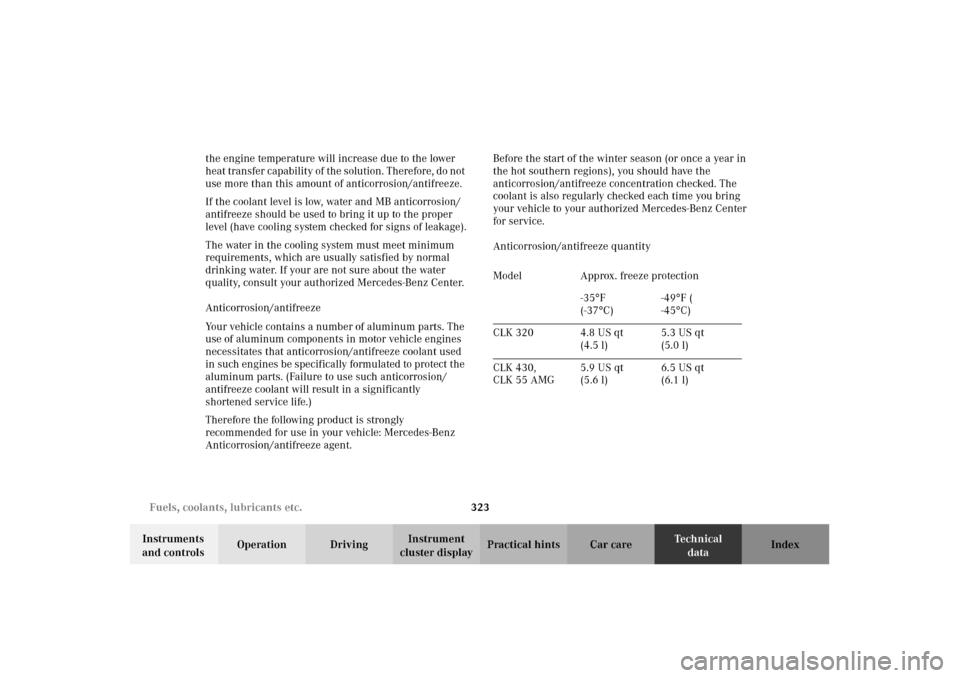
323 Fuels, coolants, lubricants etc.
Technical
data Instruments
and controlsOperation DrivingInstrument
cluster displayPractical hints Car care Index the engine temperature will increase due to the lower
heat tran sfer c ap ability of the s olution . There for e, d o n ot
use more than this amount of anticorrosion/antifreeze.
If the coolant level is low, water and MB anticorrosion/
antifreeze should be used to bring it up to the proper
level (have cooling system checked for signs of leakage).
The water in the cooling system must meet minimum
requirements, which are usually satisfied by normal
drinking water. If your are not sure about the water
quality, consult your authorized Mercedes-Benz Center.
Anticorrosion/antifreeze
Your vehicle contains a number of aluminum parts. The
use of aluminum components in motor vehicle engines
necessitates that anticorrosion/antifreeze coolant used
in such engines be specifically formulated to protect the
aluminum parts. (Failure to use such anticorrosion/
antifreeze coolant will result in a significantly
shortened service life.)
Therefore the following product is strongly
recommended for use in your vehicle: Mercedes-Benz
Anticorrosion/antifreeze agent.Before the start of the winter season (or once a year in
the hot southern regions), you should have the
anticorrosion/antifreeze concentration checked. The
coolant is also regularly checked each time you bring
your vehicle to your authorized Mercedes-Benz Center
for service.
Anticorrosion/antifreeze quantity
Model Approx. freeze protection
-35
°F
(-37°C)-49
°F (
-45°C)
CLK 320 4.8 US qt
(4.5 l)5.3 US qt
(5.0 l)
CLK 430,
CLK 55 AMG5.9 US qt
(5.6 l)6.5 US qt
(6.1 l)
J_A208.book Seite 323 Donnerstag, 31. Mai 2001 9:35 09
Page 327 of 346
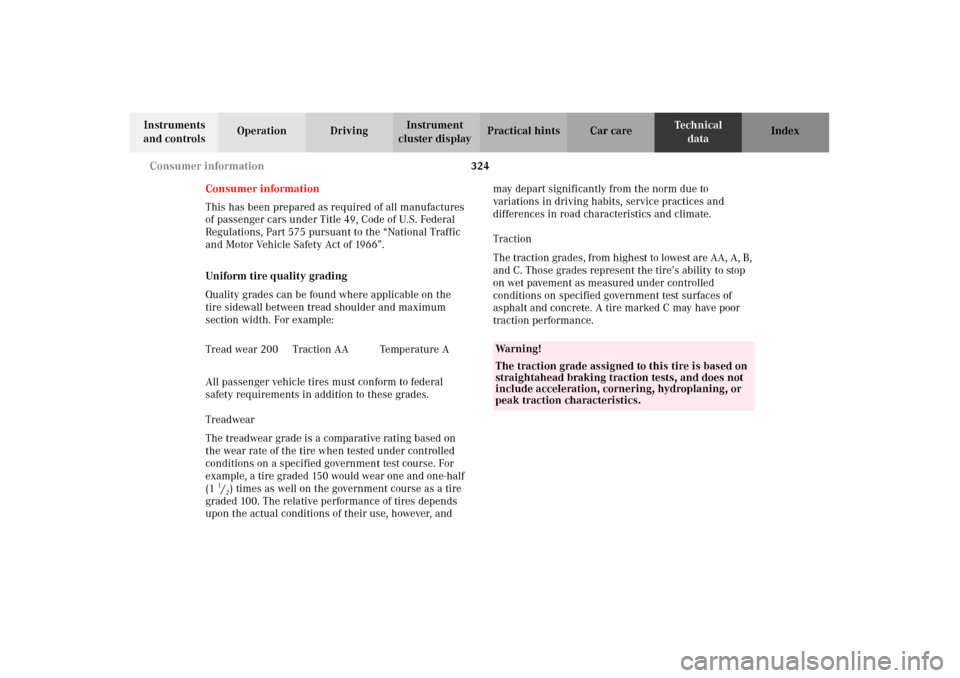
324 Consumer information
Technical
data Instruments
and controlsOperation DrivingInstrument
cluster displayPractical hints Car care Index
Consumer information
This has been prepared as required of all manufactures
of passenger cars under Title 49, Code of U.S. Federal
Regulations, Part 575 pursuant to the “National Traffic
and Motor Vehicle Safety Act of 1966”.
Uniform tire quality grading
Quality grades can be found where applicable on the
tire sidewall between tread shoulder and maximum
section width. For example:
All passenger vehicle tires must conform to federal
safety requirements in addition to these grades.
Treadwear
The treadwear grade is a comparative rating based on
the wear rate of the tire when tested under controlled
conditions on a specified government test course. For
example, a tire graded 150 would wear one and one-half
(1
1/2) times as well on the government course as a tire
graded 100. The relative performance of tires depends
upon the actual conditions of their use, however, and may depart significantly from the norm due to
variations in driving habits, service practices and
differences in road characteristics and climate.
Traction
The traction grades, from highest to lowest are AA, A, B,
and C. Those grades represent the tire’s ability to stop
on wet pavement as measured under controlled
conditions on specified government test surfaces of
asphalt and concrete. A tire marked C may have poor
traction performance.
Tread wear 200 Traction AA Temperature A
Wa r n i n g !
The traction grade assigned to this tire is based on
straightahead braking traction tests, and does not
include acceleration, cornering, hydroplaning, or
peak traction characteristics.
J_A208.book Seite 324 Donnerstag, 31. Mai 2001 9:35 09
Page 328 of 346
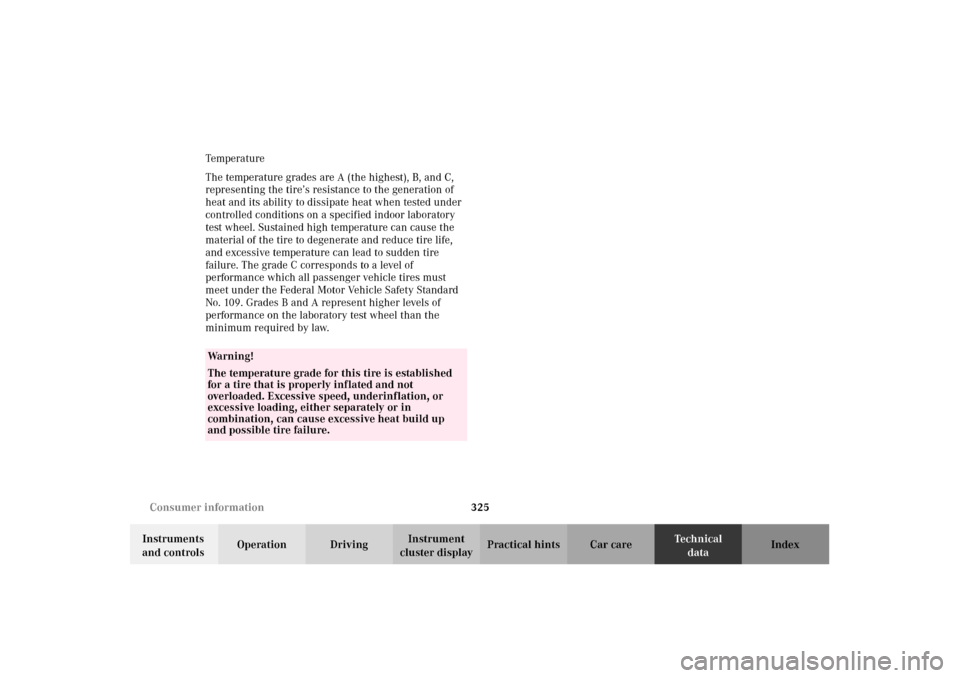
325 Consumer information
Technical
data Instruments
and controlsOperation DrivingInstrument
cluster displayPractical hints Car care Index Tempera t u re
The temperature grades are A (the highest), B, and C,
representing the tire’s resistance to the generation of
heat and its ability to dissipate heat when tested under
controlled conditions on a specified indoor laboratory
test wheel. Sustained high temperature can cause the
material of the tire to degenerate and reduce tire life,
and excessive temperature can lead to sudden tire
failure. The grade C corresponds to a level of
performance which all passenger vehicle tires must
meet under the Federal Motor Vehicle Safety Standard
No. 109. Grades B and A represent higher levels of
performance on the laboratory test wheel than the
minimum required by law.
Wa r n i n g !
The temperature grade for this tire is established
for a tire that is properly inflated and not
overloaded. Excessive speed, underinflation, or
excessive loading, either separately or in
combination, can cause excessive heat build up
and possible tire failure.
J_A208.book Seite 325 Donnerstag, 31. Mai 2001 9:35 09
Page 329 of 346
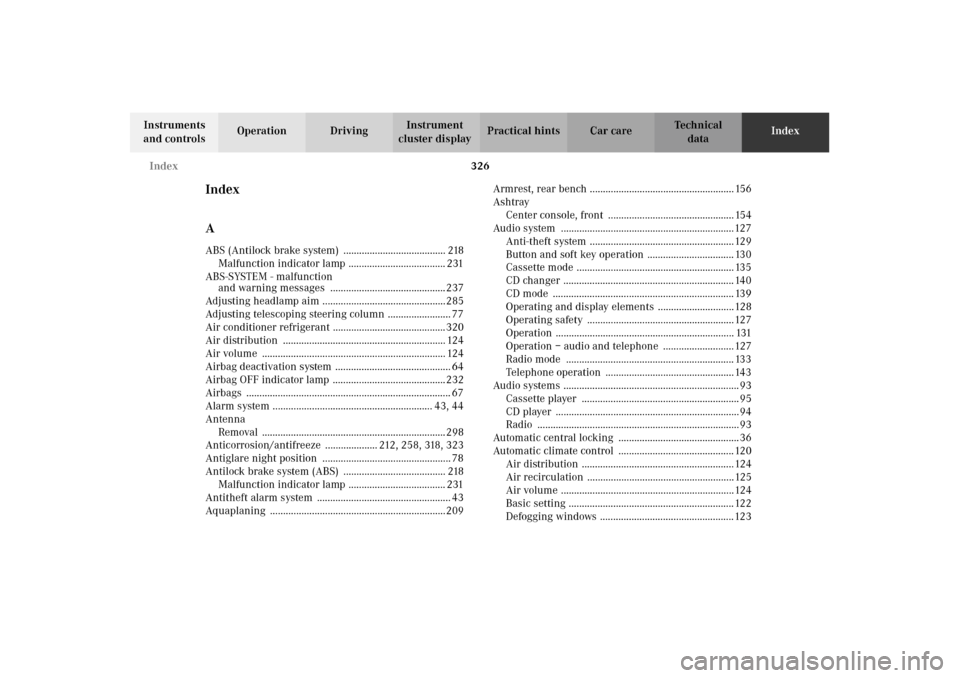
326 Index
Technical
data Instruments
and controlsOperation DrivingInstrument
cluster displayPractical hints Car careIndex
Index
AABS (Antilock brake system) ....................................... 218
Malfunction indicator lamp ..................................... 231
ABS-SYSTEM - malfunction
and warning messages ............................................ 237
Adjusting headlamp aim ...............................................285
Adjusting telescoping steering column ........................ 77
Air conditioner refrigerant ........................................... 320
Air distribution .............................................................. 124
Air volume ...................................................................... 124
Airbag deactivation system ............................................ 64
Airbag OFF indicator lamp ........................................... 232
Airbags .............................................................................. 67
Alarm system ............................................................. 43, 44
Antenna
Removal ...................................................................... 298
Anticorrosion/antifreeze .................... 212, 258, 318, 323
Antiglare night position ................................................. 78
Antilock brake system (ABS) ....................................... 218
Malfunction indicator lamp ..................................... 231
Antitheft alarm system ................................................... 43
Aquaplaning ...................................................................209Armrest, rear bench ....................................................... 156
Ashtray
Center console, front ................................................ 154
Audio system ..................................................................127
Anti-theft system .......................................................129
Button and soft key operation ................................. 130
Cassette mode ............................................................ 135
CD changer ................................................................. 140
CD mode ..................................................................... 139
Operating and display elements .............................128
Operating safety ........................................................127
Operation .................................................................... 131
Operation – audio and telephone ........................... 127
Radio mode ................................................................ 133
Telephone operation ................................................. 143
Audio systems ................................................................... 93
Cassette player ............................................................ 95
CD player ......................................................................94
Radio .............................................................................93
Automatic central locking .............................................. 36
Automatic climate control ............................................ 120
Air distribution .......................................................... 124
Air recirculation ........................................................125
Air volume ..................................................................124
Basic setting ............................................................... 122
Defogging windows ................................................... 123
J_A208.book Seite 326 Donnerstag, 31. Mai 2001 9:35 09